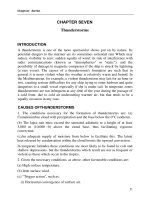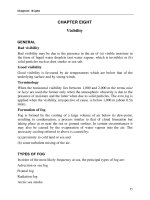BÀI GIẢNG KHÍ TƯỢNG THỰC HÀNH CHƯƠNG 1
Bạn đang xem bản rút gọn của tài liệu. Xem và tải ngay bản đầy đủ của tài liệu tại đây (96.3 KB, 7 trang )
Guide to Weather Observations for Ships
CHAPTER 1 General Description
CHAPTER 1 General Description
1.1 Introduction
As you are well aware, the navigation of ships is greatly affected by the weather. The
methodology of weather observation has been developed along with that of navigation. Weather
forecasting could find its historical origin in providing information for the safe navigation of
ships. In fact, the commencement of the storm warning in France (1856) followed an incident
where allied fleets of UK and France gathering off Sevastopol were suddenly attacked by a
severe storm and a lot of French fleets sank (14 November 1854) during the Crimean War.
Observing weather on board a ship is not only beneficial for its own security but also for the
safety of navigating ships in general through weather forecasts or storm warnings, which are
issued based upon all the available weather reports gathered by meteorological services. These
forecasts or warnings are also contributing to the prevention and reduction of meteorological
disasters affecting industries, transport systems, civil lives or various other activities on land.
Furthermore, the weather reporting of a ship on the ocean where few observed data are
available is also playing a very valuable role in monitoring the global-scale climate change in
response to the recent increasingly important issues for the whole mankind concerning climate
such as the global warming.
The Japan Meteorological Agency (JMA), the national meteorological service of Japan, put
emphasis on these important roles of weather observation on board. The operational services in
meteorology depend on wide-ranged international co-operation. The World Meteorological
Organization (WMO), one of the specialized agencies of the United Nations, is promoting
meteorological observation on board ships and its reporting along the line of the "International
Convention for the Safety of Life at Sea (SOLAS)" (1974). The WMO has established
internationally common methods of observation, codes to report the data and procedures to
exchange data among Members of the WMO.
The WMO Voluntary Observing Ship (VOS) scheme is an international programme in the
framework of which ships are recruited for making and reporting meteorological observations.
Under this scheme, the JMA requests individual ships equipped with radio communication
facilities to make meteorological observations (weather observations on board ships) and to
report the data by radio and mail.
This Guide is intended to introduce how to make marine meteorological observations and
other related matters. In addition to the guide, the JMA provides VOSs with the following
materials free of charge:
- Guide to Ships' Weather Reports,
- Ships' Weather Code Card,
- Table for Finding the Dew-point Temperature,
- JMA Cloud Plate,
- Beaufort Scale of Wind Force,
-OBSJMA (a software to make weather reports),
1
CHAPTER 1 General Description -
Operation manual for OBSJMA,
- Ship's Weather Observation Field Note for OBSJMA (see Fig.l.l),
- Marine Meteorological Logbook, and
- Envelope to send logbooks or floppy disks (postage free within Japan).
(see Appendix 1)
1.2 Careful practices
1.2.1 General notandum in observation
In order to obtain correct data, it is important for mariners to proceed meteorological
observations in a careful and minute way. An inaccurate observation could mislead the forecaster
and result in an erroneous forecast, while a correct and reliable observation would shed light on
obscure and complex meteorological conditions. Needless to say, missing observation should be
avoided. It is also necessary for the observation on board a ship to be aware not to be affected by
motion or vibration of the ship, exhaust of gas or water, or sea
spray.
It is worthwhile to pay attention to the degree of the observed quantity, surrounding
meteorological conditions and situation of ocean waves. For example, what will happen when the
atmospheric pressure is decreasing? If a tropical cyclone (e.g. typhoon) or an extra-tropical
cyclone is approaching, "wind speed" will get larger. If a front is coming near, "direction of
wind" will change and the "wind waves" will be higher. By keeping watchful of these changes,
you can reduce errors in reading measures and/ or find malfunctioning of instruments early.
Observed results should be recorded directly on the Marine Meteorological Logbook, as for
certain items, after necessary calculations (see the corresponding chapters for details) as follows:
_ Atmospheric pressure; correction of pressure to sea level to be made (see Ch.2);
- Dew-point temperature;
* if you use dry and wet-bulb thermometer, to be calculated using dry-bulb temperature,
wet-bulb temperature and pressure (see Ch.3);
* if you use dew-point hygrometer, no calculation needed;
_ Wind speed/ direction; observed (apparent) value to be corrected to true wind according to
the vector velocity of the ship (see ChA);
_ Weather (present and past); change of weather during the past 3 or 6 hours required, so
change should be recorded at any time (see Ch.7).
You are recommended to immediately make records of these resulted values on paper
prepared at hand before you fill in the logbook. Do not record any value relying on your
memory. Always remember to make sure if your observation procedures, your calculations, or
your radio weather messages are correct.
Software to make electric logbook such as OBSJMA will help you to carry out correct
weather observations and reports.
2
1.2.2 Non-instrumental Observations
Non-instrumental observations such as those of weather, cloud, or visibility are no less
important than instrumental observations in order to analyze meteorological phenomena for
detecting, for example, the movement or scale of tropical cyclones or extra-tropical cyclones.
Concerning ocean waves, only a very small number of research vessels carry out instrumental
observation and so non-instrumental observations from merchant ships are indispensable for the
analysis and forecast of ocean waves.
Non-instrumental observations depend upon the personal judgment and experience of the
observer. A fundamental basis of the modem meteorology assumes that observations are
comparable and made through the same procedures all over the world. Therefore, it is very
important to follow the instructions and procedures as indicated in this book or other related
books mentioned in 1.1.
1.2.3 Reporting time
Weather reporting from VOSs is conducted 4 times a day at 00, 06, 12 and 18 Universal
Time Coordinated (UTe) worldwide .
. The Japan Meteorological Agency (JMA) requests not only Japanese ships but also VOSs in
general navigating in the areas CD and (2) in the Fig. 1.2 to report their observations on the above
four times to the JMA. If you are located in the area of CD in the Figure 1.2 you are also requested
to report your observed data, in addition to the above times, at 03, 09, 15 and 21 UTC to the
JMA.
3
Though various observations for one reporting time can not be made at the same time, they should be
done as close to the reporting time as possible (see 1.2.4).
1.2.4 Order of Observations
In general, non-instrumental observations should be made consecutively. Avoid making
instrumental and non-instrumental observations alternately, since you need a certain time to adjust
your eyes to the sight over the sea (especially at night). Instrumental observations requiring the use of
a light should be made after non-instrumental ones, so that adjustment of your eyes to the dark is not
impaired.
With the above remarks in mind, the order of observations is generally recommended to be
proceeded as follows:
1)Sea surface temperature (in case of bucket measurement) 2)
Non-instrumental observation
- Horizontal visibility
- Cloud (amount, type, height, etc.)
- Ocean waves (wind waves, swell)
- Wind direction and speed (in case of observation by Beaufort scale)
3) Instrumental observation
- Wind direction and speed (in case of observation by anemometer)
-Air temperature and dew-point temperature
dry-bulb and wet-bulb (in case of wet-bulb thermometer) or
4
CHAPTER 1 General Description dry-bulb
and dew-point (in case of dew-point hygrometer)
- Sea surface temperature (in case of intake measurement or hull-attached thermometer)
- Atmospheric pressure to be measured exactly on time
4) Calculation and conversion to codes
5) Filling in Marine Meteorological Logbook
6) Preparing and checking of Radio Weather Message
7) Checking the complete weather report and transmitting it
Present and past weather should be observed as necessary (see 1.2.1). Software to make
weather reports such as OBSJMA will help you on the above procedure 4)-6).
1.3 Utilization of observed results
The JMA is receiving weather reports from ships directly through Radio Weather Messages
and/ or later through Marine Meteorological Logbooks mailed at Japanese ports.
Observations reported through Radio Weather Messages are immediately utilized mainly to
produce weather and ocean wave forecasts/warnings through the numerical weather and ocean
wave prediction models where observed data are utilized to make the initial field. Observations
on board ships are valuable to fill data sparse area over oceans. Though the meteorological
satellite can provide considerable observations, they are not sufficient and needs corrections
based upon data observed by ships.
Marine meteorological observation data received by the JMA as Marine Meteorological
Logbooks are edited in magnetic disks and archived after quality check. Based upon these data,
the JMA is publishing "Marine Climatological Summary" and "Marine Climatological Charts of
the North Pacific Ocean for 3D-year Period". These statistical data of marine meteorology are
being utilized not only for research activities in meteorology, climatology, and oceanography but
also for safe navigation, economical navigation, ocean development, and various other
objectives. Such statistical data are exchanged among those countries which are in charge of
archiving data for their responsible ocean areas. In response to the recent issues on understanding
and prediction of global climate changes such as global warming, meteorological observations on
board ships are providing highly valuable data filling data sparse ocean area to such activities as
monitoring global climate change, development or improvement of numerical climate modelling
and so on.
5









